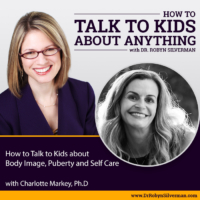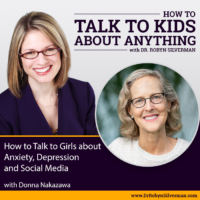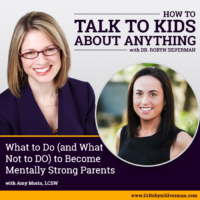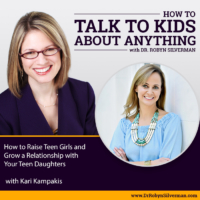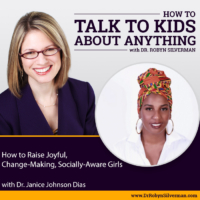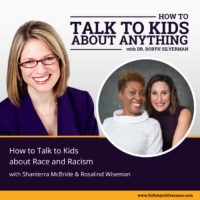Podcast: Play in new window | Download
Subscribe: Apple Podcasts | RSS | More
How to Talk to Girls about Body Image
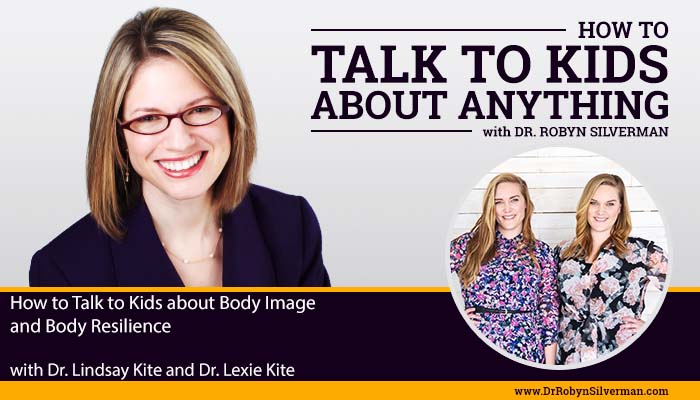
This podcast will focus on how to talk to girls about body image, body acceptance and body resilience. Dr. Robyn Silverman interviews Drs. Lindsay Kite and Lexie Kite, sisters and co-directors of Beauty Redefined about this important topic, helping girls learn that their bodies are instruments, not ornaments.
Special guests: Dr. Dr. Lindsay Kite and Dr. Lexie Kite
“How do you feel about your body?” This question can open up an avalanche of answers—focused the majority of the time on how it looks rather than what it does and can do. Body image, our attitudes and behaviors related to our bodies can infiltrate how we see ourselves but also how we engage in the world. Many of you might not know this, but a million years ago, when I was getting my PhD and writing my qualifying papers and my dissertation—body image was front and center in what I was studying. In fact, I wrote a book about body image and girls after graduating, which was published by Harlequin in 2010, called Good Girls Don’t Get Fat: How Weight Obsession is Messing Up Our Girls and How We Can Help Them Thrive Despite it. I had been putting the final touches on that book when we adopted my daughter, who is now 12, and all of this body talk has renewed personal meaning. Shortly after my book was published, I met 2 young dynamos who spoke my language—Lindsay and Lexie Kite, who were starting their own body revolution to help people see their bodies and instruments—not ornaments—something that helped us engage in the world in beautiful, interesting and fundamental ways rather than something simply to be ogled, primped, and sadly, criticized. While we have seen a larger net cast around body acceptance these days, we still have a long way to go. How does body image impact our girls today? How about the boys—where do they live in this conversation? And as parents, educators and coaches, how can we support a world that helps to see our kids bodies as instruments—rather than ornaments? For that, we will turn to Dr. Lindsay and Dr. Lexie Kite.
image, our attitudes and behaviors related to our bodies can infiltrate how we see ourselves but also how we engage in the world. Many of you might not know this, but a million years ago, when I was getting my PhD and writing my qualifying papers and my dissertation—body image was front and center in what I was studying. In fact, I wrote a book about body image and girls after graduating, which was published by Harlequin in 2010, called Good Girls Don’t Get Fat: How Weight Obsession is Messing Up Our Girls and How We Can Help Them Thrive Despite it. I had been putting the final touches on that book when we adopted my daughter, who is now 12, and all of this body talk has renewed personal meaning. Shortly after my book was published, I met 2 young dynamos who spoke my language—Lindsay and Lexie Kite, who were starting their own body revolution to help people see their bodies and instruments—not ornaments—something that helped us engage in the world in beautiful, interesting and fundamental ways rather than something simply to be ogled, primped, and sadly, criticized. While we have seen a larger net cast around body acceptance these days, we still have a long way to go. How does body image impact our girls today? How about the boys—where do they live in this conversation? And as parents, educators and coaches, how can we support a world that helps to see our kids bodies as instruments—rather than ornaments? For that, we will turn to Dr. Lindsay and Dr. Lexie Kite.
Bio
Dr. Lindsay Kite and Dr. Lexie Kite are identical twins and co-authors of the book More Than a Body: Your Body Is an Instrument, Not an Ornament and co-directors of the nonprofit Beauty Redefined. They both received PhDs from the University of Utah in the study of female body image and have become leading experts in body image resilience and media literacy. Authors of numerous studies and books have cited Lindsay and Lexie’s original research and they have been featured in a variety of national media outlets, including The New York Times, Vanity Fair, the Boston Globe, Slate, Shape, Glamour, and more. Lindsay and Lexie help girls and women recognize and reject the harmful effects of objectification in their lives through their significant social media reach, online Body Image Resilience course and facilitator program for dieticians and therapists, their popular book (More Than a Body), and regular speaking engagements for thousands of people of all ages.
Important Messages:
- We have had this constant preoccupation with losing weight, enhancing our appearance—and we thought that was the key to health, happiness, success and the
 ability to be loved. It fits in with the media narrative being sold- that when you look a certain way, you could feel a certain way and be accepted more. It was the constant pursuit of beauty.
ability to be loved. It fits in with the media narrative being sold- that when you look a certain way, you could feel a certain way and be accepted more. It was the constant pursuit of beauty. - Media narrative: That women’s bodies were so cohesively defined as thin, young, tan, no visible flaws. This was the reason why we felt obsessed with our looks and so dissatisfied with our bodies.
- What have you lost in your life by being so confined by and defined by your body? What has the world lost—by having girls and women sit on the sidelines of their own lives because we don’t feel like we qualify to be seen as we are? In exchange, what does the world have to gain—what do the individuals have to gain—in our bodies as they are regardless of how they look- because we are so much more than that- when we can all work on believing that—oh the possibilities! The progress!
- Instead of how do I look while engaging in this activity?
- When we are obsessed with our bodies- that is an issue!
- Body positivity- get coopted by brands that might exploit the message for their own gain because it resonates even if they don’t believe it. Messaging like; “all bodies are beautiful, you are more beautiful than you think, your flaws make you beautiful.” Popular body campaigns. First step- normalize different sizes and different bodies. That means non-white, non-pair shape or non-hourglass shape (curvy in all the right ways), differently abled. Seen different bodies presented in different lights- not seen as abnormal. But the thing is, they are still being celebrated for how they look rather than who people are.
- When we keep talking about “all bodies are beautiful” we are still keeping the issue at a surface level—talking about beauty. It keeps people thinking about- am I beautiful? Can I maintain this level of beauty? This feeling in confidence in beauty? This consistently ebbs and flows in this objectifying culture that consistently reminds us we’re not quite beautiful enough. Constant reminders- never enough. More to do to look better and be more beautiful. Back to this state of normative discontent- women uncomfortable in their bodies and self-objectifying them.
- Doubling: Imagining our bodies from the outside- constantly monitoring them rather than fully focused and in the moment.
- Solution? Not body positivity- although that’s a stepping stone on the way to it- but rather, body resilience. It’s the ability to recognize the harmful messages (objectification) in this culture (not going anywhere since there is so much money and profit to be made by getting women to believe that our bodies are the most important things about them—and increasingly, a message shown to all genders). With resilience- you feel those moments of disconnect- and consciously make the choice that you are going to come back home to your body instead of splitting from yourself and watching yourself from the outside. Muscle that you build over time so it doesn’t sting so much.
- Many people feel they fail at body positivity because they don’t love their body all the time. Body resilience takes over where body positivity leaves people hanging.
- Opportunity- choose a new way of coping. Living anyway. Growth in that.
- ACTIVITY: Writing a letter to your inner little girl. Imagine yourself when you are young. Picture yourself on the beach. Or think of a little kid in your life who isn’t self conscious about the looks. When did they start evaluating themselves from the outside? Back when they weren’t thinking about what other people thought about their bodies. Little kids are invited into the waters of objectifications. Moms or Dads- I shouldn’t eat that, my pants don’t fit, bullying kid who is fat. Can even be in a seemingly positive way- “I wish I had your flat tummy.”
- What would you say to her? To warn her about what’s coming? Her meaning and her worth that extends beyond her looks.
- Write a letter. Inner child work. Heal our bodies. Reunite with ourselves from the moment we split. Look at a picture of little me—or look at your children- and tell them what you needed to hear or how you needed to be treated in that moment. “I am good. I am okay. Body diversity is real.
- It’s very hard to hide your moral values from your children.
- Prepubescent girls bodies idealized.
- We might not be talking about ourselves or our daughters- but we might make comments about other people’s bodies. Celebrities. People we haven’t seen for a while. The neighbor.
- Value system is so apparent. How do we value bodies? Not just our owns- but everyone’s.
- Make explicit the implicit messages we get from when we are little kids. Inventory- roots of head to bottoms of feet. What messages? Companies manufacturing new flaws and then manufacturing new solutions.
- Normalize what you are seeing- that there are certain body rules for women that boys and men don’t have to adhere to.
- Look at movies/shows. Very few female protagonists that move the plot forward.
- “I wonder why there are no girls in this show? I wonder why they all look the same- have you noticed that?”
- MEDIA SAVVY ACTIVITY: Tiny nose- look at all the noses. How much variety? All girls have teeny tiny noses. What about in real life?
- Kelly Clarkson cover- Body Confidence Issue. When the magazine was pressed- the magazine said that they were only trying to make Kelly look her “personal best.” How to open conversations about photo-shopping and retouching- and the role it plays in how it impacts us and others.
- There are lines in female celebrities contracts that they should only be photographed in certain kind of lighting, won’t be on camera without filtered lenses and even CGI flaw removal on live TV. Technology- incredible and terrifying.
- What the kids see photos or videos on social media, they need to learn that this is not real. It has been manipulated.
- Filming our own selfies. Our faces are being flattened.
- Filtered, edited and cropped- even by the people we know and love- they are the highlight reel.
- Plant the seeds to the critical eye from an early age. They are being lied to and manipulated. Even age 5 and 6. What you are seeing in media, they want you to buy things. Toys, princess make up kits and dress up kits. We want you to know that you are loved and we will take care of ourselves throughout our lives. Bodies are instruments not ornaments.
- As important for boys to understand this than girls. Change the sexism. Draw boundaries. “In this family, with my kids, we don’t talk about people’s bodies in that way. I want my kids to know that their power and worth extend far beyond their looks and how they appear. We aren’t going to have that diet talk here. We aren’t going to have that body talk here.”
- INSTEAD: This sets people up to have different conversations with kids. Talk to girls differently. To ask different questions. To compliment them on different things. Instead of “You are so pretty! Love your beautiful dress! I bet the boys are just lining up…!” Relegating girls to the pretty sidekicks of their own lives. Paradigm shift. Beauty can’t make us and beauty can’t break us.
- SOCIAL MEDIA: Pros and cons of social media (Lindsay talks about this). Selfie objectification. Kids are tempted to get on social media earlier. Must be straightforward. Why? And potential harm. Plus what the good is on social media. It’s not unfettered access to a world of evil- there is some good stuff there! We want to help them find it.
- Hold them off as long as possible.
- Make pros and cons list. Why do they want to be on?
- Here are what the filters look like. Here’s what it looks like when someone alters their photo to look closer to an ideal. Even on your own account- show them. Hands-on. Show them that when you spend a lot of time on social media you tend to feel more isolated, anxious, jealous of others. Less unity with other girls. Because of the nature of self-comparison. Watch out for them. In addition to all the other things- like people who don’t have your best interests in mind, etc.).
- Limit screen time on social media. (Lexie talks about this). Too much research and too much direct experience that tells us that too much time on social media leads to all those negative consequences. Self-objectification, body shame, self-comparison, loneliness, envy. Real consequences. No matter how good you are at cultivating your feed.
- Cultivate your feed—so that social media can be more self help than self harm.
- IG/Tic Toc- image-centric platforms. Algorithm promotes to girls/women very body-centric and beauty-centric information.
- Avoid “explore page.” Funneled to us. Some of the harmful stuff.
- Evaluating the photos you are choosing to put up- 200 photos later- looking at your chin, your side, your belly…how is it going to be perceived? Taking away from the experience.
- “Selfie objectification.” Seeing ourselves as objects. Body image world- “show us your selfie” to show us that you love yourself. What you don’t see is the 160 other photos they took from different lighting, different filters, different angles, then cropped, and put a sparkle on top of it! To put on IG or Tic Toc. Doesn’t promote body confidence- promoted body objectification- seeing your body as an object to be judged and then seeking validation from the way people engage with it. Y
- ASK: Are you fully engaged in your life? Splitting? Or are you taking selfies of yourself to reflect a certain image of yourself to the rest of the world? Value self as bodies first and people second. When you are more engaged with your life- more satisfied and happy, you tend to post less! Cut back!
- Health wrapped in with body size, fat. How do we tease apart health vs fat/thin/weight/BMI? Tease apart definitions for self. We tend to lump in these things together and evaluate our own fitness by weight, BMI, dress size, external measurement. We have learned our whole lives that this is how you evaluate your health and fitness. Thinking this is a good stand in- but it’s not. Studies in exercise physiology over the last 10 years show the truth- that the people who are active are healthier than those who are inactive.
- How to answer: “I’m so fat” Instead of “no you’re not, you’re perfect and beautiful.” Which sets fat up to be in opposition to being beautiful, loveable, perfect or healthy. When they do this- recognize that they are saying- I’m afraid I’m not good enough. I’m afraid I’m not loveable. Because I’ve learned from others that thinner is better. I looked at my round belly and realized I don’t fit the thin ideal. Instead- “All bodies come in different shapes and sizes- mommy’s/daddy’s bodies are different, what really matters is how we feel and what we do. We can repeat the mantra, “My body is an instrument, not an ornament.”
- For little kids- inappropriate to put them on a diet- damaging to their health. Coming into their own bodies. On average, puberty, 40 pounds.
- The most important step we can take to see ourselves as more than a body, to see our bodies and an instrument not an ornament is to reconnect with our bodies when we are tempted to split. Deep breathing. Relax your stomach Back to that little girl. Reconnect and heal- come back home.
- Top tip: Instrument not ornaments. Paradigm shift necessary for adults and kids. Value to self- and value others. Neutral approach to people’s bodies. Reflects for compassion. Growing up in world that makes it difficult to feel okay in your body. Experience flow. Creativity. Excitement. Joy. Live fully, Hopefully. Encourage live- and get out to do the things you want to do. When you know you are more- you can make progress.
Notable Quotables:
- “What have you lost in your life by being so confined by and defined by your body? What has the world lost—by having girls and women sit on the sidelines of their own lives because we don’t feel like we qualify to be seen as we are? In exchange, what does the world have to gain—what do the individuals have to gain—in our bodies as they are regardless of how they look- because we are so much more than that- when we can all work on believing that—oh the possibilities! The progress!”
- It is good that we are seeing different bodies presented in different lights but the thing is, they are still being celebrated for how they look rather than who people are. When we keep saying that “all bodies are beautiful” we are still keeping the issue at a surface level—talking about beauty.
- “Body image resilience allows you to see those moments of disruption [that make body shame come up, make you want to diet or get a procedure or turn to substance abuse] and consciously make the choice that you are going to come back home to your body instead of splitting from yourself and watching yourself from the outside.”
- “Look at an old photo of you and tell yourself what you needed to hear when you were young. Treat yourself now, how you needed to be treated in that moment. Say, ‘I am good. I am okay. Body diversity is real.’ To be able to heal that person in that long line of genes- to honor and not degrade- we can reconnect with ourselves and heal ourselves. It allows us to interact with children in a more compassionate and loving and less objectifying way.
- “Make explicit the implicit messages we get from the time we are just little kids. Take inventory from the roots of heads to bottoms of feet. What messages are we receiving? Companies manufacture new flaws and then manufacture new solutions that we are told to buy to correct those flaws.”
- “When you can help kids to realize that most of the images, even from those people who they know and love, are likely filtered, edited, cropped- they are the highlight reel- it sets them up to be more critical.”
- “We are going to try really hard in our family to know that we are so valuable and worthy regardless of how we look and we are going to take care of ourselves because our bodies are instruments not ornaments.”
- “We need to set up a new paradigm shift where beauty can’t make us and beauty can’t break us. We are more.”
- “There is so much money in place to make sure you stay on the app, that you keep scrolling, to try to fulfill a need that is created by being on the app. It’s an endless loop.” (Lexie)
- “The most important step we can take to see ourselves as more than a body is to see our bodies as an instrument not an ornament and to reconnect with our bodies when we are tempted to split. To come back home into your physical body—your embodiment- your physical senses- in those moments- when your heart rate is up, your flushed, you’re embarrassed and you are making plans for ways to fix yourself…That’s when we can reconnect and heal. We come back home.”
The most important step we can take to see ourselves as more than a body is to see our bodies as an instrument not an ornament, says @TakeBackBeauty on #talktokids podcast. Listen in here!
Click To Tweet
Resources:
- Book: More than a Body: Your Body is an Instrument Not an Ornament
- Instagram: Beauty_Redefined
- Website: http://www.MoreThanABody.org
Social Media for Dr. Robyn:
- facebook.com/DrRobynSilverman
- twitter.com/DrRobyn
- instagram.com/DrRobynSilverman
- facebook.com/HowToTalkToKidsaboutAnything
The post How to Talk to Girls about Body Image with Dr. Lindsay Kite and Dr. Lexie Kite appeared first on drrobynsilverman.com.

